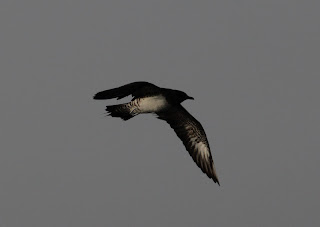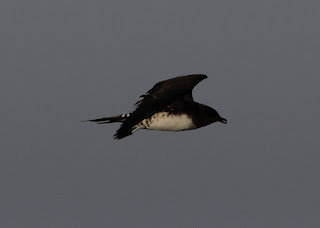The Long-tailed Skua has an Arctic distribution. It breeds discontinuously in the tundra of the Palaearctic and Nearctic, approximately between 60° and 80° N. It winters in the open sea, between southern South America, South Africa and the Antarctic. The migratory movements, like the distribution outside the reproductive period, are poorly known, but they seem to be almost entirely marine. The presence of dark morphs prevails in the distribution range of the nominal subspecies, while individuals of the subspecies pallescens (eastern Siberia and Nearctic) are mostly light or intermediate. It should be noted that many dark morph juveniles, which are seen in western Europe in autumn, do not necessarily turn into dark morph adults!
Taken from De Hoyo et al 1991
This species is highly migratory; in western Europe adults return north off the Outer Hebrides in mid to late May, often in medium to large groups flying very high & purposefully north. Another migration route (of the same birds)? is just off the northern coast of Iceland. These individuals then turn eastwards to reach their breeding grounds. This species is highly reliant on the population of Lemmings found in the high Arctic. One year after the population of Lemmings crash, so does the breeding population of Long-tailed Skuas. This is a cyclic pattern.
As stated above, this species non-breeding season distribution is not well known. It just seems to disappear into the vastness of the Atlantic & Pacific Oceans. Outside of the breeding season, it seems to be the most pelagic of all the skuas, often being seen hundreds of kilometres from the nearest land. A curious fact is that Long-tailed Skuas are not often recorded in the Indian Ocean. This was thought to be becasue of the gap far to the north, in its high arctic breeding range. Birds moving west & eastwards, rather than the more straight line, but potentially more perilous journey overland, to reach the nearest ocean.
The other factor in this species not being recorded frequently is the difficulty in identification. This species comes in three colour morphs: dark; intermediate and light. in addition the plumage stages from juvenile, through first summer to finally adult, are quite complex and varied. A further difficulty is to separate this species from the much more familiar Arctic Skua, which also has complex plumages in various stages of its life cycle and colour morphs. A further bias, is that many observers are not familiar with this species and tend to call any problematic or distant skuas as being automatically Arctic Skuas. This is not helpful in gathering information on the true distribution and status in the region, infact it actually hampers it. Observers in this region, are mainly from western Europe, where they are familiar with the much commoner Arctic Skua as a bird of passage. It is only in the last thirty years that the true status of Long-tailed Skuas has been known in Europe. For example, in the heavily watched North Sea, particularly off the Yorkshire coast, observers including myself, revolutionised the status of this species by a concerted sea watching effort over many years. The numbers passing south vary tremendously & reflect both the breeding success and the fluctuating numbers breeding in the high Arctic.
Within the UAE, Long-tailed Skua has always been regarded as rare on passage in both spring & autumn.
Over the last few years, there has been an increase in effort of seawatching from the east coast and recently the use of fast boats to go offshore, has further increased the number of records. However, there has been a reticence from some members of the Emirates Bird Records Committee (EBRC) to accept records if they are not full adults complete with long tail. This reflects their own lack of experience with this species, as they are uncertain of the identifiction features to make a 100% identification. The following notes should help to rectify this situation and make observers in the UAE more aware of the occurrence of this species & some of the plumages that occur here.
Over the last few years, there has been an increase in effort of seawatching from the east coast and recently the use of fast boats to go offshore, has further increased the number of records. However, there has been a reticence from some members of the Emirates Bird Records Committee (EBRC) to accept records if they are not full adults complete with long tail. This reflects their own lack of experience with this species, as they are uncertain of the identifiction features to make a 100% identification. The following notes should help to rectify this situation and make observers in the UAE more aware of the occurrence of this species & some of the plumages that occur here.
However, before we going into specific identification criteria, a general comment on the pattern of seabird distribution may be in order. Many species of seabirds breed in the far north and migrate south during the non-breeding season and spend the majority of their life at sea. But there is a trend here, in that only full adults complete the full migration; going that extra distance to reach the optimal wintering grounds. Immatures often abort long distance migrations and linger in areas well to the north of where adults normally spend the off-season. This phenomena is common not only in seabirds, but also in many migratory wading birds that also breed in the high Arctic. Areas further north, see immature birds in months of the year that areas further south don't.
It would appear that Long-tailed Skuas, along with the other smaller species of Skua fit this pattern. For example, from my own records in the UAE all my records of Pomarine and Arctic Skuas in winter are of immature birds. I don't think I have seen an adult from December through to early March. I believe that this is due to the adults wintering far to the south of the UAE, so we don't record them until they migrate further north. Arctic Skuas generally peaking in numbers before Pomarine Skuas. This makes perfect sense as Pomarine Skuas breed in greater numbers in the very high Arctic (together with varying numbers of Long-tailed Skuas). The Arctic Skuas centre of breeding distribution, is slightly further south. Therefore Arctic Skuas pass through before the other two species, because their optimum time for breeding is slightly before the others due to the lateness of the spring further north and east compared to western Europe. Adult Long-tailed Skuas should be passing off the UAE coast, in the latter half of May and early June. It may well be that second summer birds & adults in their first breeding season might pass north even later in mid June. It is these individuals that will either arrive on their breeding grounds too late, or they will abort their long distance migration and come back south. So it is quite possible to record these rather inexperienced birds in the summer months in the extreme north-west Indian Ocean. I would expect the records of Long-tailed Skuas to slightly increase, in line with the more frequent offshore boat trips to look for pelagic species.
Intermediate morph Long-tailed Skua
Notice the attenuated rear end
Small size & quick wing beats -
give this species a diferent look from Arctic Skua.
The following photographs are taken from the internet. They show & reinforce the identification points that I have already made. Long-tailed Skuas are variable in plumage & having three colour morphs doesn't help! Notice the bulky chest in some of these photos. For its size, Long-tailed Skua has a broad & powerful chest. This is often seen to best advantage in profile.

Photo coutesy of Rob Morris.
Notice the attenuated rear ends
(even without the long tails being present).
Photo courtesy of Stephane Aubry.
Large eye & dainty bill & small head,
give a different feel for this species over Arctic Skua.
Photo courtesy of Graham Catley.
Look at the head & bill shape.
Also notice the distinctive upperwing pattern.
Small head & bill, heavily barred rump.
Distinctively restricted white wing flash
in the primaries.
Extensively barred underwing pattern, with grey tones.
The white wing flash on the underwing is much more
extensive than on Arctic Skua
(which often looks much darker on the underwing).
All the underwing features can clearly be seen here.
Notice the boldly barred flanks, characteristic of this species.
Notice the small head & bill.
The bill is short for a skua.
The dark head & chest is common on
intermediate morph Long-tailed Skuas.
Notice the upperwing pattern.
This is different from Arctic Skua.
Long-tailed Skua.
Dark primaries contrasting with wing coverts
and dark trailing edge.
Restricted white in primaries is obvious.
and dark trailing edge.
Restricted white in primaries is obvious.
Showing the classic, first summer
upper & lower wing pattern.
Dark & boldly marked flanks are very obvious.
A good view of the underwing pattern & flanks.
Notice the dark & cold tones of the plumage.
Notice the dark & cold tones of the plumage.
The second Long-tailed Skua -
light morph, first summer.
Photo courtesy of Huw Roberts.
Notice the underwing pattern
Photo courtesy of Huw Roberts.
A nice profile view.
Photo courtesy of Huw Roberts.
Photo coutesy of Rob Morris.
Photo coutesy of Rob Morris.
Photo courtesy of Devitch Farbotnik.
Photo courtesy of Devitch Farbotnik.
Photo courtesy of Devitch Farbotnik.
Photo courtesy of Tim Avery
This individual is very similar to our second Long-tailed Skua, that proved difficult to photograph. It is a first summer pale morph bird.
Photo courtesy of Tim Avery
Photo courtesy of Brian R. Field.
Intermediate morph.
Photo courtesy of Darren Hughes
Pale morph.
Pale morph.
Photo coutesy of Rob Morris.

Photo coutesy of Rob Morris.
Notice the attenuated rear ends
(even without the long tails being present).
Photo courtesy of Stephane Aubry.
Large eye & dainty bill & small head,
give a different feel for this species over Arctic Skua.
Photo courtesy of Graham Catley.
Look at the head & bill shape.
Also notice the distinctive upperwing pattern.
Photo courtesy of Glyn Sellors.
Photo courtesy of Tim Avery
Photo courtesy of Tim Avery
Photo courtesy of Don Doolittle.
A fine adult Long-tailed Skua.
Photo courtesy of Glyn Sellors.











































Steve,
ReplyDeleteThe dark morph adult of Long-tailed Skua is incredibly rare - if it even exists. It certainly isn't the regular form of the nominate race.